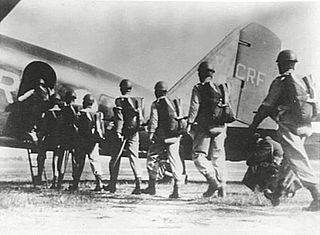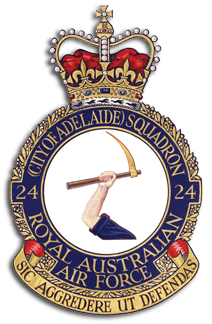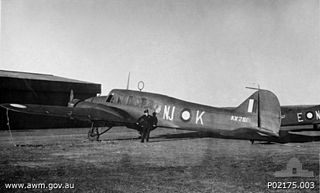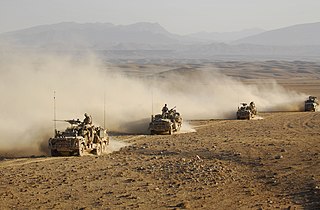
A parachutist badge is a military badge awarded by the armed forces of many states to soldiers who have received parachute training and completed the required number of jumps. It is difficult to assess which country was the first to introduce such an award.

RAAF Base Richmond is a Royal Australian Air Force (RAAF) military air base located within the City of Hawkesbury, approximately 50 kilometres (31 mi) North-West of the Sydney Central Business District in New South Wales, Australia. Situated between the towns of Windsor and Richmond, the base is the oldest base in New South Wales and the second oldest in Australia. The base is home to the transport headquarters RAAF Air Lift Group, and its major operational formations, Nos. 84 and 86 Wings. The main aircraft type operated at the base is the Lockheed C-130 Hercules. Richmond is a regular venue for air shows and had at times been mooted as a site for Sydney's proposed second international airport.

No. 30 Squadron is a squadron of the Royal Australian Air Force (RAAF). Raised in 1942 as a long-range fighter unit, the squadron saw action in the Second World War, serving in the South West Pacific Area against the Japanese and operating mainly in the ground attack and anti-shipping roles from bases in New Guinea and the Netherlands East Indies. After the war, the squadron was disbanded, however, it was re-raised a short time later as a unit of the part-time Citizen Air Force, operating in the target towing and air defence role in New South Wales. In 1960s the squadron ceased flying aircraft and operated surface-to-air missiles, providing for the defence of Sydney and Darwin before disbanding in 1968. The squadron was re-raised again in 2010 and since then it has served as an airbase support squadron located at RAAF Base East Sale.

No. 4 Squadron is a Royal Australian Air Force squadron composed of the air force special forces Combat Controllers, aircrew who operate the Pilatus PC-21 aircraft and instructors for the Australian Defence Force Joint Terminal Attack Controller (JTAC) course.

The 1st Parachute Battalion was a parachute infantry battalion of the Australian Army. Raised for service during the Second World War, it was formed in early 1943 from volunteers for airborne training. Despite achieving a high level of readiness, the battalion did not see action during the war and was disbanded in early 1946.

No. 5 Squadron was a Royal Australian Air Force training, army co-operation and helicopter squadron. The squadron was formed in 1917 as a training unit of the Australian Flying Corps in Britain, readying pilots for service on the Western Front. It subsequently became a naval fleet co-operation squadron, but was later redesignated as No. 9 Squadron RAAF before being re-formed as an army co-operation squadron during World War II. In the mid-1960s, it was re-formed as a helicopter squadron, before being disbanded in December 1989, when it was used to form the Australian Defence Force Helicopter Training School.

No. 452 Squadron is a Royal Australian Air Force (RAAF) air traffic control unit. It was established in 1941 as a fighter squadron, in accordance with Article XV of the Empire Air Training Scheme during World War II. The squadron flew Supermarine Spitfires for the entire war, initially over the United Kingdom and Nazi-occupied Europe. It was later based in Australia and the Netherlands East Indies, before being disbanded in 1945. It was re-raised in its current role in February 2011.

No. 24 Squadron is a Royal Australian Air Force squadron. The squadron was formed in 1940 and saw action as a bomber squadron during World War II serving in the Pacific theatre against the Japanese, and undertaking operations during the Battle of Rabaul, and the New Guinea, New Britain and Borneo campaigns. The squadron was disbanded in 1946 following the conclusion of hostilities, but was re-formed in 1951. From then until 2010 the squadron was an RAAF Reserve squadron located near Adelaide, South Australia; for part of this time, until 1960, the squadron continued to perform flying duties, before converting to a ground support role. In 2010, the squadron combined with Combat Support Unit Edinburgh to become a Permanent Air Force unit and it currently forms part of No. 96 Wing, Combat Support Group.

No. 84 Wing is a Royal Australian Air Force (RAAF) transport wing. Coming under the control of Air Mobility Group (AMG), it is headquartered at RAAF Base Richmond, New South Wales. The wing comprises No. 35 Squadron, operating Aliena C-27J Spartan transport Aircraft; No. 37 Squadron, operating Lockheed Martin C-130J Super Hercules medium transports; and a technical training unit, No. 285 Squadron.

No. 73 Squadron was a Royal Australian Air Force (RAAF) maritime patrol squadron of World War II. It was formed in July 1942 and conducted patrols off the east coast of Australia until July 1944. The squadron was disbanded in September 1944.

The special forces of the Australian Defence Force are units of Special Operations Command and associated units of the Royal Australian Navy and the Royal Australian Air Force that conduct and or support special operations to advance and protect the national security of the Commonwealth of Australia. The special forces of Australia have a lineage to a variety of units raised in the Second World War such as the Independent and Commando Companies, Z Special Unit, Navy Beach Commandos, and the Coastwatchers. Australian special forces have most recently been deployed to Iraq in Operation Okra as the Special Operations Task Group, as the Special Operations Task Group in Afghanistan, in Afghanistan in support of the Australian Secret Intelligence Service and regularly for counter-terrorism pre-deploy to locations of major domestic events throughout Australia in readiness to support law enforcement such as the 2014 G20 Brisbane summit.

No. 5 Operational Training Unit was an operational training unit (OTU) of the Royal Australian Air Force. It was formed at Wagga Wagga, New South Wales, in October 1942 to train pilots and navigators for service in World War II. The unit was initially equipped with Bristol Beauforts and Beaufighters, and later received Douglas Bostons and de Havilland Mosquitos, among other types. No. 5 OTU was transferred to Tocumwal in October 1943, and then to Williamtown in mid-1944. It was reorganised as a fighter conversion unit flying P-51 Mustangs and CAC Wirraways in February 1946, and disbanded in July 1947.

The Australian Defence Force Parachuting School is an Australian Army unit part of the Defence Special Operations Training and Education Centre (DSOTEC) that provides training in parachuting techniques, develops parachute doctrine and techniques and conducts trial-evaluations of parachute systems and associated equipment. The school is based adjacent to HMAS Albatross, Nowra, New South Wales.

No. 8 Service Flying Training School was a flying training school of the Royal Australian Air Force (RAAF) that operated during World War II. It was formed in December 1941, and graduated its first course in March 1942. Responsible for intermediate and advanced instruction of pilots under the Empire Air Training Scheme (EATS), the school was based at RAAF Station Bundaberg, Queensland, and operated Avro Anson aircraft. It spawned two maritime patrol squadrons in early 1943, raised in response to increased Japanese submarine activity off Australia's east coast. Some of the school's aircraft were also attached to the Australian Army in 1944–45. No. 8 SFTS completed its final training course in December 1944, and was disbanded in July 1945.

Airborne forces raised by Australia have included a number of conventional and special forces units. During the Second World War the Australian Army formed the 1st Parachute Battalion; however, it did not see action. In the post-war period Australia's parachute capability was primarily maintained by special forces units. In the early 1980s a parachute infantry capability was revived which led to the Parachute Battalion Group forming in 1983 based on the 3rd Battalion, Royal Australian Regiment. In 1997, a full time commando regiment was raised that was able to conduct large-scale operations which matured during the 2000s. In 2011, 3 RAR relinquished the parachute role with the Army deciding to opt out of a conventional parachute capability in preference to a special forces large-scale parachute capability.

The 1st Mountain Battery was an Australian Army artillery battery formed in July 1942, that served during the Second World War, seeing action against the Japanese during the Battle of Buna–Gona and the Salamaua–Lae campaign in 1942–43. The unit was added to the 1st Parachute Battalion in August 1944 providing an organic indirect fire support, equipped with Short 25-pounder guns, but did not see further action in this role. The battery was disbanded in 1946.

The New Guinea Air Warning Wireless, also known as the "New Guinea Air Warning Wireless Company", "NGAWW", or "The Spotters", was a unique signals unit of the Australian Army formed in January 1942 in Port Moresby, Territory of Papua, during World War II, to provide early warning of Japanese air attack, and subsequently providing surveillance of shipping and ground-based troops. During the first month of operations 16 stations were established, with positions set up along the Papuan coast as well as in the mountains near Port Moresby. They often operated behind Japanese lines and were at risk of being captured by the Japanese due to the nature of their operations, while a number of outstations were over-run and the men manning them killed. By the end of 1942 the company was maintaining 61 operational stations and had a strength of 180 men.

Alan Charles Rawlinson, was an Australian airman who became a fighter ace in World War II. He was credited with at least eight aerial victories, as well as two aircraft probably destroyed, and another eight damaged.


















